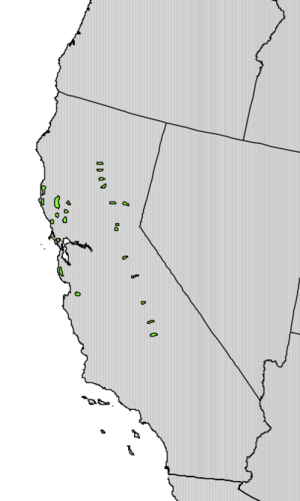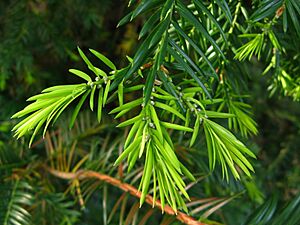California torreya facts for kids
Quick facts for kids California torreya |
|
|---|---|
 |
|
| Conservation status | |
| Scientific classification | |
| Genus: |
Torreya
|
| Species: |
californica
|
 |
|
| Natural range | |
The Torreya californica is a special type of cone-bearing tree found only in California, USA. It's often called the California torreya or California nutmeg tree. You can find it growing in the Pacific Coast Ranges and the foothills of the Sierra Nevada. Even though it's called "nutmeg," it's not related to the spice you might have in your kitchen!
Contents
What Does the California Torreya Look Like?
The California torreya is an evergreen tree, which means its leaves stay green all year. It can grow quite tall, usually between 15 and 25 meters (about 50 to 80 feet). Its trunk can be as wide as 0.5 to 1 meter (about 1.5 to 3 feet) across. The tree has a cone shape, with branches growing in circles around the trunk.
Leaves and Cones
The leaves of this tree are like stiff, sharp needles. They are about 3 to 5 centimeters (1 to 2 inches) long and 3 millimeters (about 0.1 inches) wide. They grow in a spiral pattern around the branches, but they twist so they lie flat on each side of the shoots.
Male cones, which produce pollen, are small, only about 5 to 7 millimeters long. They grow in lines under the shoots. Female cones, which produce seeds, grow alone or in small groups. They start very tiny and take about 18 months to grow. When they are ready, they look like a small, fleshy fruit, dark green to purple, with a single large seed inside. This seed is about 2.5 to 4 centimeters (1 to 1.5 inches) long.
How People Use California Torreya
Long ago, Native Americans in Northern California used the seeds of the California torreya as food. The wood from the tree was also used to make bows for hunting.
Today, the wood is sometimes used to make boards for the game of Go. It's a more affordable choice compared to the very expensive kaya wood from Japan, which comes from a similar tree.
Growing California Torreya
People sometimes plant the California torreya in gardens as a beautiful ornamental tree. It's also used in larger projects that focus on native plants or traditional landscapes.
Where Does the Name Come From?
The name Torreya honors Dr. John Torrey (1796-1873). He was an American botanist who helped write the Flora of North America, a big book about plants in North America.
The word californica simply means 'from California', telling us where this tree naturally grows.
See also
 In Spanish: Torreya californica para niños
In Spanish: Torreya californica para niños



